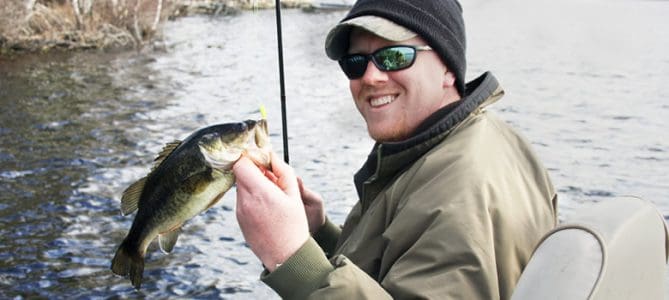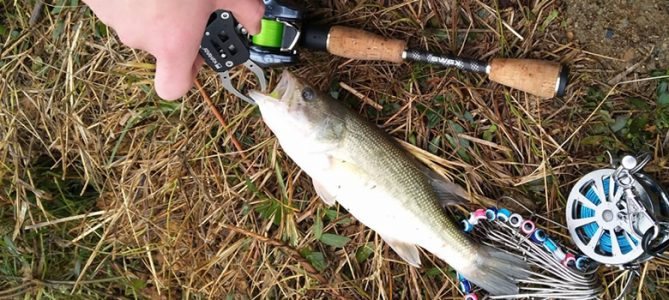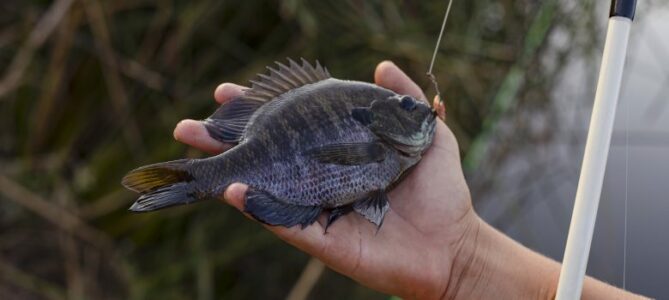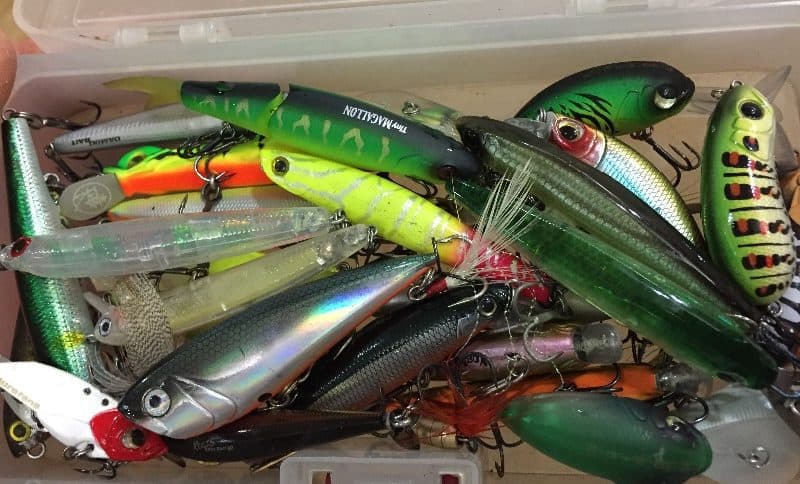If you buy via a link on this page, we may receive a commission, at no extra cost to you.Learn more
Chances are if you’ve landed here, you probably love the taste of bass. Whether you are new to bass fishing as a sport or you have years of experience, you’re looking at this page because you enjoy the art of catching bass. And chances are, no matter what level you are at, you want to become better at catching bass.
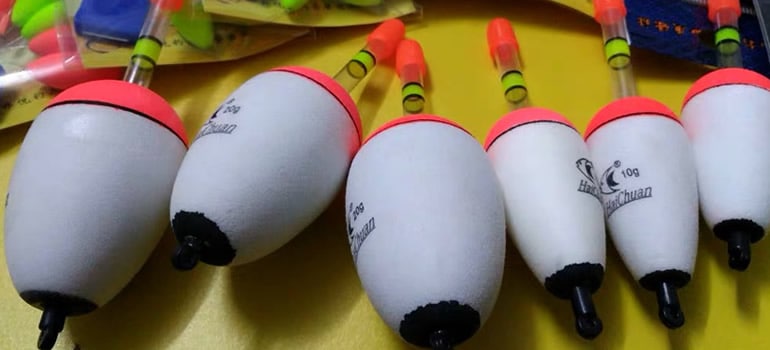
So, how do you catch bass with a bobber? While you might feel tempted to purchase the most expensive equipment with the newest technology, stop before you shop. Save your money and start with affordable products. It’s best to learn how to bass fish and then purchase materials as you learn more.
We put together this bass fishing guide because we didn’t find much out there about how to catch bass with a bobber. While you might come across a few tips on bass fishing here and there, there aren’t many in-depth guides out there.
How to Catch Bass with a Worm and Bobber
If you’re new to bass fishing, it can be discouraging to spend a day out on the lake and not catch anything. That’s especially true if you’re new to the sport. If you are dying to experience that little tug on your line when you are fishing for bass, then using the simple earthworm and bobber rig should be enough to catch bass.
You don’t need anything particularly fancy when you fish for bass. Merely walking through the fishing section of your local Walmart and selecting a cheap bobber and worm bait should be enough if you already have your reel.
What’s nice about a bobber rig and worms is not only the essential simplicity of the products but how inexpensive and easy to use the combination is. Also, the bobber rig and earthworm combination are sufficient enough to attract freshwater bass.
If you want to produce successful results with a worm and bobber, then you need to start by taking baby steps. People often go overboard and rig with too many worms on hooks that are too large featuring extra huge bobbers. While this might seem like a good recipe, it creates a disaster.
Using a combination of a large rig, too much worm, and a large bobber means you might get several nibbles, but you’ll lose your bait and catch fewer fish. Instead, you should use a small hook. After all, a small hook will grab small bass, but it’s still competent enough to catch more massive bass.
Also, using a smaller amount of a worm on your hook works better than overdoing the amount of worm you offer out to bass. Avoid threading the whole nightcrawler onto your hook at all costs. If you use too much nightcrawler, the fish will snack on a section of the worm, steal your bait, and never bite your hook.
Since you want to avoid bass bait thievery, bait instead with a small one-inch part of the worm. Also, when selecting a bobber, purchase a smaller one. A large bobber isn’t ideal because it doesn’t cue well.
On the other hand, a small bobber tends to be more sensitive than a large bobber to fish biting. Also, a small bobber creates less resistance to bass, allowing the fish to grab the bait and hook more easily.
You also want to leave a small space between the bobber and the hook. The area should measure between one to two feet. That way, your worm stays in front of the fish, which will prevent your hook from catching on the bottom.
If you want to get your feet wet with this technique, then grab a small piece of worm and put it on a #4, #5, or #6 hook with a small bobber. Then, crimp a small split-shot sinker onto your line right under the bobber. Make sure there is enough weight to keep the bobber upright. However, ensure that the bobber won’t sink too much.
Remember that by using fresh bait, you’ll be creating natural scents in the water that attracts fish. So, if your worm sits in the water too long and starts looking soggy or white, then you’ll want to replace it. That way, you’ll keep attracting bass.
Why is Bass Fishing So Popular?
In the United States, bass fishing is one of the most popular approaches to fishing around. Probably the most sought-after bass in North America is the largemouth bass. At least 14 million people in the United States make catching bass their favorite sporting event.
Bass fishing’s popularity boomed because of the fact fishing for bass in America is so easy. Bass fishing is not only a hobby for adults in the United States but also children. Bass is so prolific in the United States that most people do not need to travel far to pursue the fish. Many individuals go to their favorite local bodies of water and start fishing.
To demonstrate how prolific bass is in North America, they live in 49 out of 50 states. Bass can be found in Hawaii as well as in areas of Canada and Mexico. While fishing for bass might not be fantastic in every one of those areas, you can see that plenty of opportunities to fish for bass exist all over North America.
Bass fishing is also prevalent in North America because it’s a sport that one can pursue year-round and at any time of the day or night. While there are certain seasons when it’s easier to catch bass and particular times of day that also increase your chances of finding this kind of fish, that’s beside the point. The point is that bass fishing offers many opportunities in America.
Bass fishing is so prevalent in America not only because of how prolific the fish are but also because of the enjoyment people get out of the sport. If you’ve ever fished for bass before, then you know that bass put up a fight and are exciting fish to catch.
Plus, the bass is predators, so they are almost always eating and out hunting. So, if you find you aren’t hooking bass with your bait or the location you’ve been fishing in isn’t turning up any nibbles, all you need to do is alter your strategy. You can take a walk a little further up the lake and find bass easily in a different area.
Different Kinds of Bass
While there is a bevy of different kinds of bass species in the world, we’ll focus in on the most popular bass you’ll find in North America, also known as “black bass.” Below we cover some of the types of bass that are in this family, including largemouth and smallmouth bass.
Largemouth Bass
The most popular type of bass to fish for in the United States, largemouth bass are famous for their enormous mouths. Largemouth bass typically flies solo, but on occasion, you might find them bunched up together. That happens when there is plenty of food in that particular area.
The largemouth bass is predatory, practically existing on top of their environmental food chain. Since largemouth basses are usually the top predators in their areas, they are often aggressive fish. That means they won’t just nibble at your bait; they’ll attack it from out of nowhere.
You’ll often find largemouth bass hiding between rocks. Sometimes they stay in and around vegetation, under submerged logs and branches, and any place that looks like an excellent hiding spot so that they can grab prey. Largemouth bass typically spends time waiting in their hiding spots and then come out to snatch their next victim.
If you’re fishing for largemouth bass, then note that they prefer to live in warm, quiet water. So, fishing for largemouth bass is typically produced in ponds and lakes. However, you can still find largemouth bass living in rivers and streams. When you search for them, focus on calm, slow-moving water areas.
Smallmouth Bass
Smallmouth bass sometimes called “smallies” offers yet another opportunity to catch a fun, prolific fish. Like largemouth bass, smallmouth bass also fights when you find them, providing a bit of an enjoyable challenge. They are also known to be very acrobatic when they’re trying to get off of a hook.
For example, many of us who fish for bass have memories of smallmouth bass hopping out of the water, flipping, spinning around, and doing everything they can to get free from their hook. Because of the gymnastics performed by many smallmouth basses while people are chasing them, they are a prevalent fish to catch, too.
Smallmouth bass differs from largemouth bass because they travel together instead of alone. That means you’ll find groups of smallmouth bass more often than largemouth bass. On occasion, however, smallmouth bass sometimes lives alone if they are found in areas where bass fishing is thinner.
Smallmouth bass also differs from largemouth bass when it comes to where they like to live. While largemouth bass like to live in quiet, warmer bodies of water, you’ll find smallmouth bass instead in colder, cleaner water. Smallmouth bass is commonly located in rivers, streams, lakes, and reservoirs.
Smallmouth bass does not like living in polluted, dirty water. They prefer clean water. So, if you find smallmouth bass in an area, then you know you’re in a good location.
Step by Step Instructions on Catching Bass with a Bobber
Using a bobber to fish for bass is quite simple to learn. However, if you’re new to using a bobber when you catch bass, then don’t fret. We’ve got a simple step-by-step breakdown for you below. Here is how you find a bass with a bobber:
- Step 1: First, attach your bobber stop to your line. If you’re not sure what a bobber stop is, it’s the small, narrow plastic tube you thread your line through when you fish. Ensure that the stop offers some resistance on the line and pull the string tightly. That way, the stop can move up and down to control the depth of your fishing.
- Step 2: Grab a bead that is sized correctly. Then, attach it to your line. Make sure the bead can slide along the line. You want to make sure you use a bead because the bead can stop the bobber from moving past the bobber stop.
- Step 3: Now, you attach your bobber. Remember, you can purchase a bobber in a variety of sizes, but we suggested the sizes above that will help you catch bass. Run your bobber through the line. You should now have a bobber, bead, and bobber stop on your line.
- Step 4: Now go to the end of your line. Make sure you add a correctly sized hook. We mentioned hook sizes for bass as well above. Make sure you tie the hook to the end of the line. Use a secure knot when you link it so that you don’t lose your hook while you are fishing.
- Step 5: Now, you want to add some weight to your line. That way your line will suspend from the bobber beneath the water. If you don’t add any weights, then your line probably won’t slide through correctly. To add an appropriate weight, pinch slip shot sinkers on the line. Place it between the hook and bobber. Ensure that you place the weight a few inches from your hook at the very least.
Now you should have everything you need tied to one line so that you can start fishing for bass. Remember that the bobber stop slides up and down the line to help you figure out the length for your fishing. So, if you want the line to go 6 inches under the water, then you need to move the stop 6 inches above the hook.
Next, you’ll cast the line. The Slip bobber will float and should sink about 6 inches of your line with the bait and hook underneath the water. You can usually also adjust your stop bobber when you need to.
To help you understand how to cast your line and fish for bass, we’ll review some cast and retrieve techniques below, and guide you through those steps.
Bass Fishing Techniques: The Yamamoto Senko Worm
Using the right techniques makes bass fishing simple. The sport of bass fishing doesn’t have to be as tricky as it sounds. After all, children can catch bass easily. That’s because catching bass doesn’t require any fancy gear or approaches, which makes chasing after these fish so enjoyable.
Bass fishing can be as simple as casting and retrieving. The more experienced you get with bass fishing, the more you’ll notice the different types of bass fishing techniques you can learn. Every different type of bass fishing technique offers its own benefits.
However, since we’ve been talking about using worms here, we’ll cover a simple technique you can use with your worm and bobber.
Cast and Retrieve Bass Fishing
One way you can approach fishing with a bobber is by using the cast and retrieve bass fishing technique. We’ve included the steps for this below.
- Step 1: Decide where you want to cast the worm and cast it. Then, let it sink to the bottom. Once the worm sinks to the bottom, allow the worm to sit in place on the bottom for a period of time. While it might surprise you to learn this, I’ve managed to catch several basses during this waiting period.
- Step 2: If you don’t feel a nibble, wait a few minutes. Then, pull the tip of your rod up so that the worm looks like it’s alive to the fish. Drag the worm on the bottom and use your rod alone to move the bait along.
- Step 3: After you’ve done that, reel in any slack as your worm starts to rest. Make sure you keep your line taught while doing this.
- Step 4: Repeat the lift and reel retrieval until the worm comes back to you. Once you pull the nightcrawler back to you, repeat the process.
Keep in mind that basses are predatory. So that means they like to move around often and aren’t always sticking around the same place. Instead, they tend to move around while looking for prey.
So, if you aren’t catching any bass while sitting in the same area for a while, try to recast to the right. After that, move back to the left. It’s a good idea to move around more when fishing for bass since bass tends to be the type of fish that’s out searching for food often.
Also, when looking for bass, don’t forget to cast into the shallow water close to the shoreline. If you are fishing in the early morning or late evening when the bass is the most active, this is the perfect area with which to catch.
Now that you know how to fish for bass and where to find them, it’s time to hit the great outdoors!

